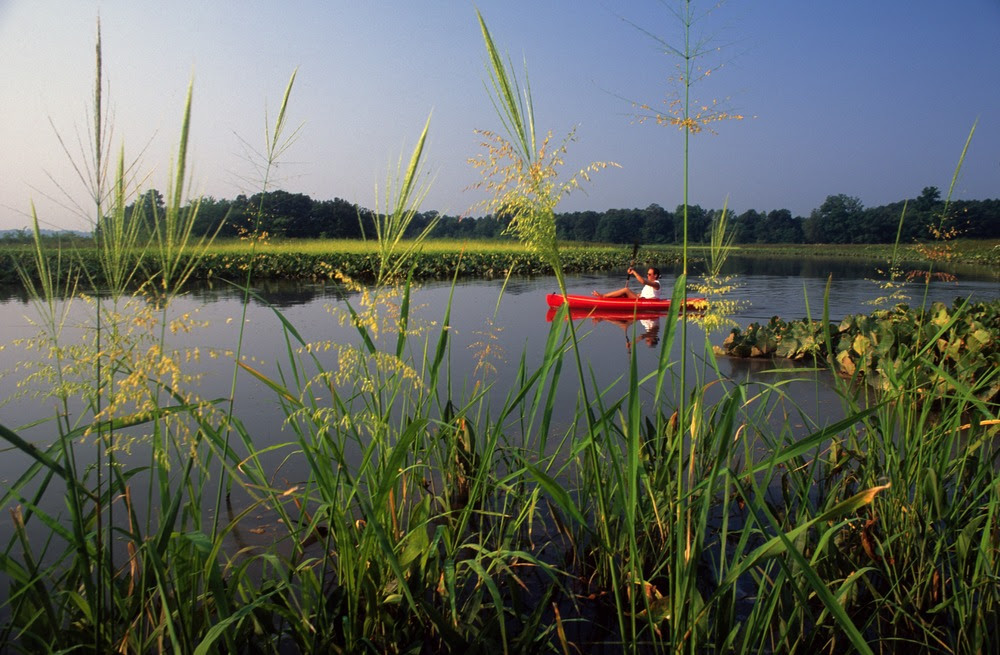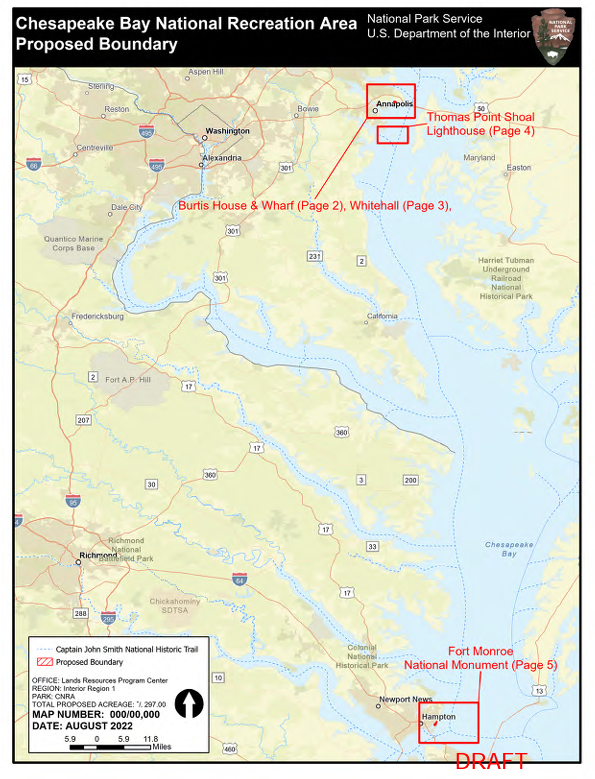U.S. Senator Van Hollen and U.S. Representative John Sarbanes Release Discussion Draft Legislation for Public Comment Prior to Introduction in Congress
The Chesapeake Bay is considered one of the last significant coastal landscapes in the United States yet to gain national recognition. The idea to honor and celebrate the Chesapeake Bay as a unit of the National Park System has been proposed, studied, advocated and considered for over 35 years.
The long-held vision took a notable step forward when Senator Chris Van Hollen (D-MD) and Representative John Sarbanes (D-MD-3) held a press conference on November 14, 2022 with local leaders and stakeholders to announce a proposal to establish a Chesapeake National Recreation Area (CNRA). Prior to introducing a bill in the House and Senate, the two legislators released a “discussion draft” of the CNRA legislation and are seeking public comments on the proposal through February 12, 2023.
View a recording of the CNRA press event.
The release of a discussion draft is an important opportunity for the public, CCP members and partners to review the proposal and help guide the CNRA legislation.
Although the National Park Service (NPS) provided formal drafting services at the request of Senator Van Hollen, during this phase it is the policy of the NPS to not comment on pending legislation until a bill is introduced in Congress and the agency is asked to testify.
To review the discussion draft legislation and provide comments, visit:
https://www.vanhollen.senate.gov/cnra
To provide an overview of the proposal, the following passage is a reprint of the Fact Sheet posted on the CNRA discussion draft website linked above:
Chesapeake National Recreation Area Fact Sheet
Senator Chris Van Hollen and Congressman John Sarbanes have released draft legislation that would designate a unified Chesapeake National Recreation Area (CNRA) as part of the National Park System.
The discussion draft legislation was developed through collaboration with a broad range of stakeholders represented on the working group that Senator Van Hollen and Congressman Sarbanes convened last year. The Chesapeake National Recreation Area would utilize a collection of partnerships with states, localities, and private entities with the intent of highlighting the landscape and national significance of the Chesapeake Bay. This would deliver more federal resources to the watershed region, celebrate its diverse cultural and economic history, conserve the Bay’s environment, and foster public access to this national treasure while also spurring economic growth.
The CNRA will increase diverse public access to the Chesapeake Bay and strengthen the culture of stewardship across the region. Additionally, the CNRA will highlight the stories that often go untold – those of Indigenous peoples; free and enslaved Blacks; the role the Bay played in the earliest days of the Maryland and Virginia Colonies; the key part the Bay has played, and continues to play, in the region’s economy; and the story of watermen and -women who are essential to the economic success and health of the Bay region. Everyone who resides in the watershed has an important role in Bay conservation and culture.
Draft Version of Proposed Boundary (Photo Credit: National Park Service)
Through this draft legislation:
- The National Park Service (NPS) will be permitted to acquire or partner with Burtis House, Whitehall Manor, Thomas Point Shoal Lighthouse, and the North Beach of Fort Monroe by voluntary sale or donation to serve as the first sites within the CNRA;
- A CNRA Advisory Commission of local stakeholders will be tasked with advising the NPS on the design and implementation of the CNRA management plan and make recommendations for additional partner sites and property to be added to the CNRA;
- NPS may only acquire additional lands or property through voluntary donation, purchase from a willing seller, exchange, or transfer from another agency in consultation with the CNRA Advisory Commission;
- NPS can enter into voluntary “opt-in” partner site and cooperative management agreements with and provide federal funding to state and local governments, tribal governments, non-profit organizations, educational institutions, and private landowners that wish to be included in the CNRA, in consultation with the CNRA Advisory Commission;
- The Superintendent of the NPS Chesapeake Bay Office will administer the existing Chesapeake Gateways Program in coordination with the CNRA; and Permanently reauthorize the Chesapeake Gateways Program at $6 million annually.
This draft legislation explicitly would not:
- Authorize NPS to impose any additional regulations on recreational or commercial business activities in the Chesapeake Bay waters, including existing water navigation and fishing activities;
- Authorize NPS to supersede state authority in fish and wildlife management efforts;
- Authorize NPS to acquire property from unwilling landowners; nor
- Authorize NPS to impose any additional regulations governing non-participating private or public landowners.
A Brief History of the CNRA:
The concept of the Chesapeake National Recreation Area has been discussed as far back as the 1980s, spurred by an op-ed in the Capital Gazette and work by Anne Arundel County Executive Jim Lighthizer and later followed in the 1990s by the efforts of Senator Paul Sarbanes. Driven by Senator Sarbanes, in 2004, the National Park Service (NPS) released a special resource study which found that the Chesapeake Bay is “unquestionably nationally significant and a major part of the nation’s heritage.” Shortly after Senator Van Hollen’s election to the Senate, the Senator and Congressman John Sarbanes began discussing the possibility of a designated Chesapeake National Recreation Area. In 2019, the lawmakers began working on the effort, requesting drafting service from NPS to pursue a national recreation area designation for the Chesapeake Bay. The effort has garnered widespread bipartisan support, and in 2020, Maryland Governor Larry Hogan and Virginia Governor Ralph Northam shared their backing of the concept in letters to Congress. Senator Van Hollen and Congressman Sarbanes continued to pursue the effort, and in 2021, formally announced a working group to foster further discussion with stakeholders and community members on the project. In June 2022, the lawmakers released a set of guiding principles to serve as a foundation for the draft proposal. The release of the discussion draft for comment is the next significant milestone in this historic process. Those interested in more closely reviewing and providing feedback can do so at https://www.vanhollen.senate.gov/CNRA
Members of the CNRA Working Group:
Senators Ben Cardin (D-Md.), Mark Warner (D-Va.), and Tim Kaine (D-Va.) and Representatives Bobby Scott (D-Va.), Rob Wittman (R-Va.), and Elaine Luria (D-Va.); the State of Maryland; the Commonwealth of Virginia; Chesapeake Conservancy; the Chesapeake Bay Commission; the National Parks Conservation Association; Choose Clean Water Coalition; the Conservation Fund; the Chesapeake Bay Foundation; Maryland League of Conservation Voters; Nature Conservancy; Potomac Conservancy; REI; the National Trust for Historic Preservation; the American Sportfishing Association; the National Marine Manufacturing Association; the Watermen of Maryland; the Sport Fishing Commission; Historic Annapolis; Oyster Recovery Partnership; Blue Oyster Environmental LLC; Preservation Virginia; Shellfish Growers of Virginia; the James River Association; Virginia Interfaith Power & Light; Marine Trades Association of Maryland; the Audubon Naturalist Society; Living Classrooms; the Hispanic Access Foundation; Latino Outdoors; Southeast Rural Community Assistance Project (SERCAP); Chispa Maryland; Baltimore Tree Trust; Blacks of the Chesapeake Foundation, Clean Chesapeake Coalition, Verna Harrison Associates, Maryland Department of Natural Resources Sport Fisheries Advisory Commission; the National Aquarium; Morgan State University Patuxent Environmental & Aquatic Research Laboratory; and The Wilderness Society.
Image credit:
- Kayaking at Jug Bay (Photo Credit: National Park Service)
Lightning Update is a regular communication of the Chesapeake Conservation Partnership. Any opinions expressed are those of the authors and do not necessarily reflect positions of the Partnership or member organizations.
To share a success story, news, or important event, send your information to:
Support for the Chesapeake Conservation Partnership is provided by:
National Park Service Chesapeake
EPA Chesapeake Bay Program
USDA Forest Service
Pennsylvania Department of Conservation & Natural Resources
Maryland Department of Natural Resources
Virginia Outdoors Foundation
US Fish & Wildlife Service
Chesapeake Conservancy
The Chesapeake Conservation Partnership is co-convened by:





